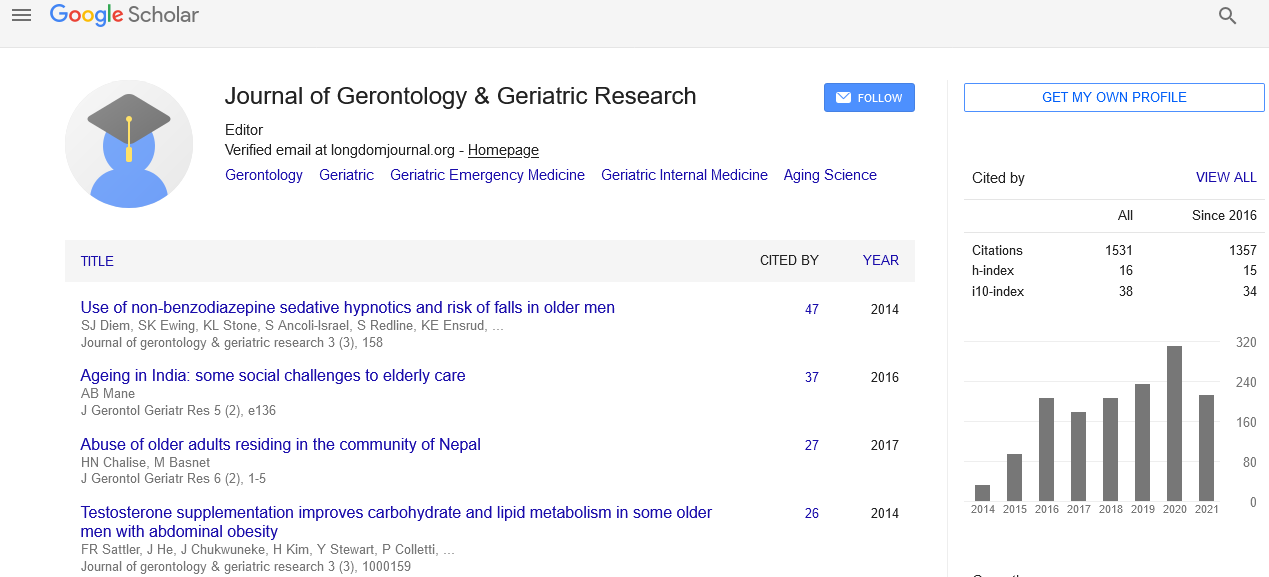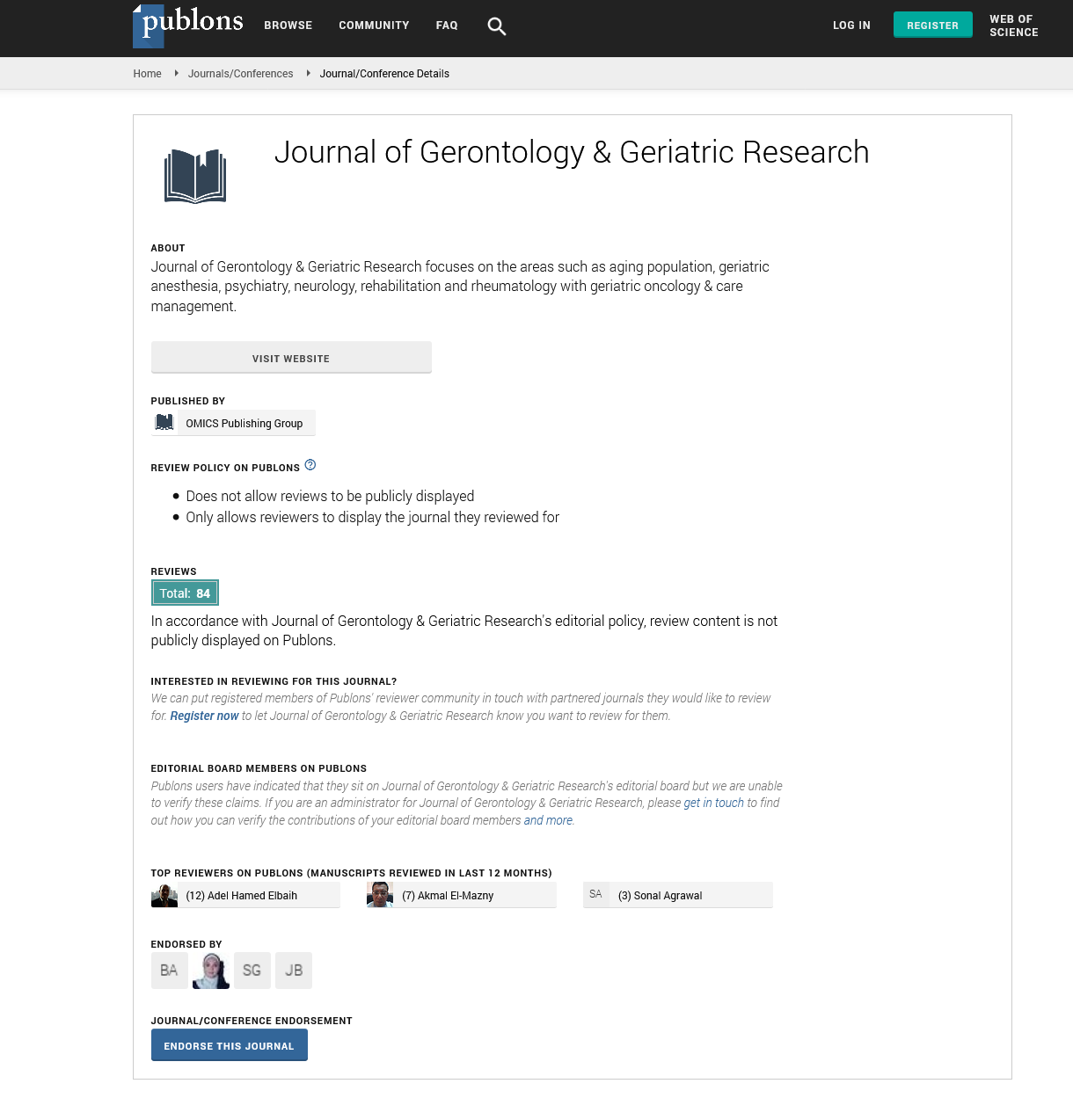PMC/PubMed Indexed Articles
Indexed In
- Open J Gate
- Genamics JournalSeek
- SafetyLit
- RefSeek
- Hamdard University
- EBSCO A-Z
- OCLC- WorldCat
- Publons
- Geneva Foundation for Medical Education and Research
- Euro Pub
- Google Scholar
Useful Links
Share This Page
Journal Flyer

Open Access Journals
- Agri and Aquaculture
- Biochemistry
- Bioinformatics & Systems Biology
- Business & Management
- Chemistry
- Clinical Sciences
- Engineering
- Food & Nutrition
- General Science
- Genetics & Molecular Biology
- Immunology & Microbiology
- Medical Sciences
- Neuroscience & Psychology
- Nursing & Health Care
- Pharmaceutical Sciences
Editorial - (2022) Volume 11, Issue 3
Editorial Note on Aging and Signs of Ageing
Martin Lee*Received: 02-Mar-2022, Manuscript No. jggr-22-16480; Editor assigned: 04-Mar-2022, Pre QC No. P-16480; Reviewed: 09-Mar-2022, QC No. Q-16480; Revised: 14-Mar-2022, Manuscript No. R-16480; Published: 19-Mar-2022, DOI: 10.35248/2167-7182.22.11.601
Editorial
Nearly 90% of signs of premature skin maturation, skin damage, and skin cancer are caused by repeated exposure to strong light (UV radiation) from the sun. The sun is cancerous and damaging to the skin. Over time, a few minutes of exposure to the sun each day can induce noticeable changes in the skin. In a broader sense, ageing can apply to solitary cells inside an organism that have stopped dividing, as well as a species' population. Photo ageing takes place over a long period of time. Something really significant happens as the sun is exposed more and more. The skin never overlooks, similar to an elephant. And with each offence, it loses its ability to repair itself, resulting in an accumulation of injury [1].
Rehashed bright (UV) presentation has been shown to break down collagen and obstruct the blend of unneeded collagen. Ageing in humans refers to the gradual accumulation of changes in a person's physical, psychological, and social characteristics through time. The sun also damages our elastin. Sun-damaged skin stops regenerating far sooner than skin that has been protected from UV rays. The second is a senescence-based definition, which outlines age-related changes in an organism that negatively impair its vitality and functional performance, increasing its death rate over time. With unprotected exposure to daylight, skin also becomes free, wrinkled, and rough considerably sooner." This treatment will also increase and increase the wrinkle count. This starts with free radicals, which are highly reactive tiny atoms that can injure almost any atom in the body, including the vital cellular structures located within the body's largest organ, the skin. This is the skin's first line of defence against intruders from the outside, such as microscopic organisms and diseases. Irritation also initiates the tissue-repair process and reduces the damage to skin cells caused by common chemicals and pollutants. Muscles have a reduced ability to respond to exercise or damage, and sarcopenia (the loss of muscular mass and strength) is prevalent. Maximum oxygen consumption and heart rate reduction [2,3].
Hardening of the blood arteries and courses is the most prevalent change in the cardiovascular system, requiring your heart to work harder to pump blood through them. The cardiac muscles adapt to the increased workload. Your heart rate will stay about the same at rest, but it will not increase as much during exercise as it did previously. Because addressing all of these pathways at the same time leads to cumulative gains in longevity, it's likely that most of them effect ageing separately. These modifications increase the risk of high blood pressure (hypertension) and other cardiovascular issues. Incorporate physical activity into your daily routine. Try walking, swimming, or other exercises that you enjoy. Regular direct physical activity can help you maintain a healthy weight and reduce your risk of heart disease. It's a pity to say that sugar accelerates the ageing process [4,5]. Glycation causes the skin's proteins to lose their ability to function normally, and it is now well recognised as a factor in accelerated skin ageing. Glycation occurs when large amounts of glucose atoms come into contact with the collagen and elastin strands in the skin. Chemical bridges between proteins can be formed as a result of this cross-connecting. Glycated filaments can become stiff, less flexible, and have a lower regeneration capacity, resulting in skin damage such as laxity, splitting, and shrinkage.
Conflicts of Interest
The authors declare no conflict of interest.
REFERENCES
- Ho CY, Dreesen O. Faces of cellular senescence in skin aging. Mech Ageing Dev. 2021;198:111525.
- Haydont V, Bernard BA, Fortunel NO. Age-related evolutions of the dermis: Clinical signs, fibroblast and extracellular matrix dynamics. Mech Ageing Dev. 2019;1:177:150-156.
- LeBrasseur NK, Tchkonia T, Kirkland JL. Cellular senescence and the biology of aging, disease, and frailty. Nestle Nutr Inst Workshop Ser. 2015;83:11-18.
- Jakubietz RG, Kloss DF, Gruenert JG. The ageing hand. A study to evaluate the chronological ageing process of the hand. J Plast Reconstr Aesthet Surg. 2008;61:681-686.
- Alexander GM, Rogan SC, Abbas AI, Armbruster BN, Pei Y, Allen JA, et al. Remote control of neuronal activity in transgenic mice expressing evolved G protein-coupled receptors. Neuron. 2009;63:27-39.
Google Scholar, Crossref, Indexed at
Google Scholar, Crossref, Indexed at
Google Scholar, Crossref, Indexed at
Google Scholar, Crossref, Indexed at
Citation: Lee M (2022) Editorial Note on Aging and Signs of Ageing. J Gerontol Geriatr Res. 11: 601.
Copyright: © 2022 Lee M. This is an open-access article distributed under the terms of the Creative Commons Attribution License, which permits unrestricted use, distribution, and reproduction in any medium, provided the original author and source are credited.


